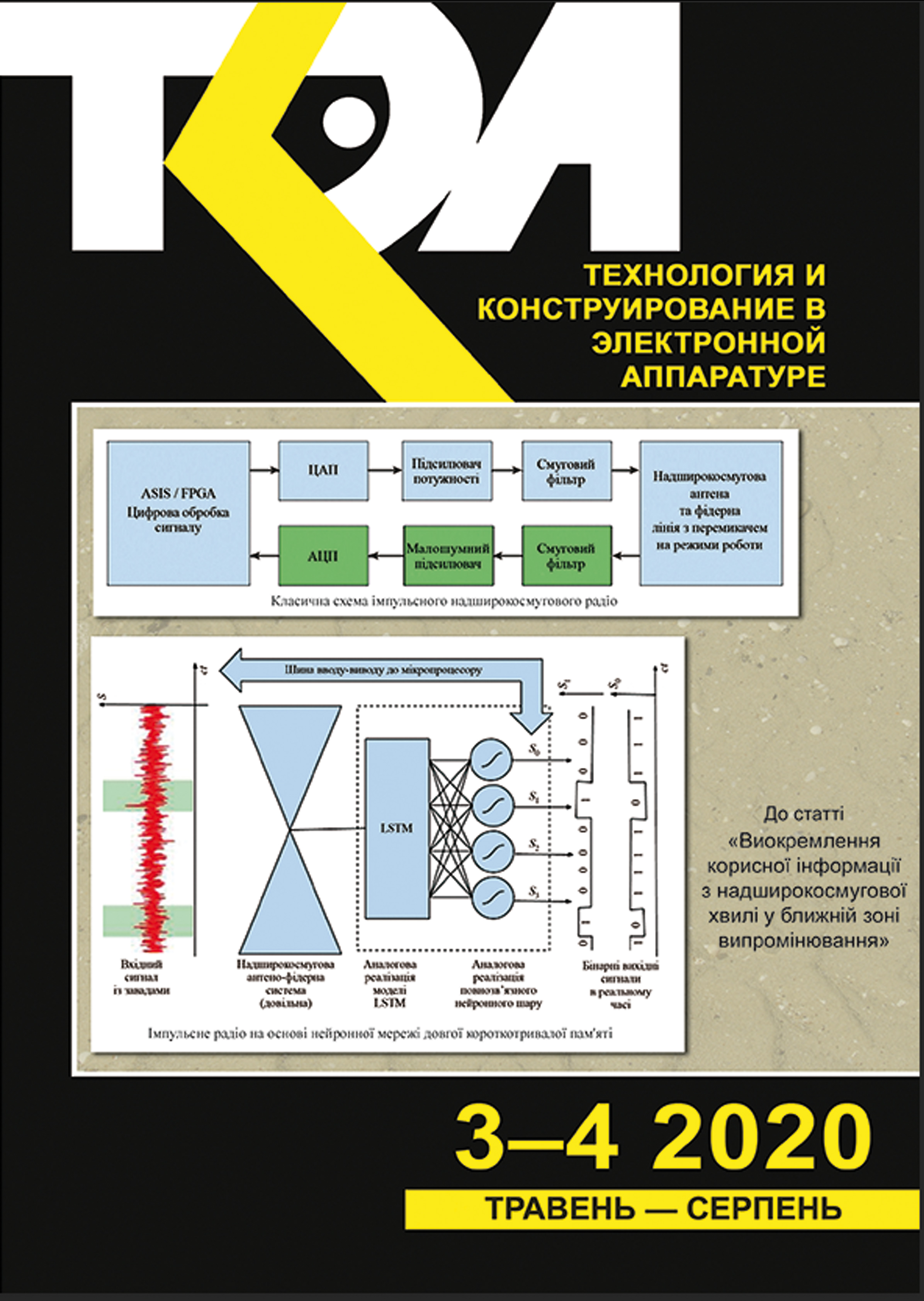Experimental study of a compact cooling system with heat pipes for powerful LED matrices
Abstract
LED light sources, and powerful multichip light sources in particular, are currently widely used for lighting household and industrial premises. With an increase in power, the amount of heat increases as well, which leads to an increase in the temperature of semiconductor crystals and, accordingly, to a decrease in the reliability of LEDs and a change in their photometric characteristics. Therefore, when developing the design of LED lighting devices, special attention is paid to thermal management. Since the early 2000s, heat pipes have been widely used to efficiently remove heat from powerful electronic components. They do not require power for moving the working fluid and are most suitable for use in LED luminaires.
In this study, the authors carry out a computer simulation of a cooling system based on heat pipes, which is then used to design and test a powerful compact LED lamp with a thermal load of up to 100 W.
Heat pipes with a length of 150 mm are used to remove heat from the LED light source to the heat exchanger rings located concentrically around it. The heat exchanger rings are cooled by natural convection of the ambient air. The results of computer modeling of the temperature field of the developed cooling system show that at a power of the LED light source of 140.7 W, the temperature of the LED matrix case is 60.5В°C, and the experimentally measured temperature is 61.3В°C. The experimentally determined thermal power of the LED matrix is 91.5 W. The p-n junction temperature is 79.6В°C. The total thermal resistance of the cooling system is 0.453В°C/W. The obtained results indicate the effectiveness of the developed design.
References
Korbutyak D.V., Kovalenko O.V., Budzulyak S.I. et al. Light-emitting properties of A2B6 semiconductor quantum dots. Ukrainian Journal of Physics. Reviews, 2012, vol. 7, iss. 1, pp. 48–95. http://archive.ujp.bitp.kiev.ua/index.php?lang=uk&item=r&id=12 (Ukr)
Klimov V.I. Nanocrystal Quantum Dots., USA, Boca Raton, CRC Press, 2010, 485 p.
Rudko G.Y., Vorona I.P., Fediv V.I. et al. Luminescent and optically detected magnetic resonance studies of CdS/PVA nanocomposite. Nanoscale Research Letters, 2017, vol .12, iss. 1, pp. 130–137. https://doi.org/10.1186/s11671-017-1892-4
Skobeeva V.M., Smyntyna V.A., Sviridova O.I. et al. Optical properties of cadmium sulfide nanocrystals obtained by the sol-gel method in gelatin. Journal of Applied Spectroscopy, 2008, vol. 75, iss. 4, pp. 576–582. https://doi.org/10.1007/s10812-008-9074-x
Mandal P., Talwar S.S., Major S.S., Srinivasa R.S. Orange-red luminescence from Cu doped CdS nanophosphor prepared using mixed Langmuir–Blodgett multilayers. Journal of Chemical Physics, 2008, vol.128, iss. 11, pp. 114703–114710. https://doi.org/10.1063/1.2888930
Lee H., Yang H., Holloway P.H. Functionalized CdS nanospheres and nanorods. Physica B: Condensed Matter, 2009, vol. 404, iss. 22, p. 4364–4369. https://doi.org/10.1016/J.PHYSB.2009.09.020
Yuan S.Q., Ji P.F., Li Y., Song Y.L., Zhou F.Q. Unusual blueshifting of optical band gap of CdS nanocrystals through a chemical bath deposition method. Advances in OptoElectronics, 2015, vol. 2015, 5 p. https://doi.org/10.1155/2015/317108
Smyntyna V., Semenenko B., Skobyeyeva V., Malushyn M. Effect of surface on the luminescence properties of CdS nanocrystals. Electronics and information technologies, 2012, iss. 2, pp. 45–50. http://elit.lnu.edu.ua/pdf/2_4.pdf (Ukr)
Kupchak, I., Serpak, N., Kapush, O., Korbutyak, D. Electronic Properties of Surface Vacancies in CdS Nanocrystals. Physics and Chemistry of Solid State, 2018, vol. 19, iss. 1, pp. 34–39. https://doi.org/10.15330/pcss.19.1.34-39
Korbutyak D.V., Kladko V.P., Safryuk N.V. et al. Synthesis, luminescent and structural properties of the Cd1–xCuxS and Cd1–xZnxS nanocrystals, Journal of Nano- and Electronic Physics, 2017, vol. 9, iss. 5, p. 05024. https://doi.org/10.21272/jnep.9(5).05024
Muruganandam S., Anbalagan G., Murugadoss G. Synthesis and structural, optical and thermal properties of CdS:Zn2+ nanoparticles. Applied Nanoscience, 2014, vol. 4, iss. 8, pp. 1013–1019. https://doi.org/10.1007/s13204-013-0284-z
Unni C., Philip D., Smitha S.L. et al. Aqueous synthesis and characterization of CdS, CdS:Zn(2+) and CdS:Cu(2+) quantum dots. Spectrochimica Acta, Part A: Molecular and Biomolecular Spectroscopy, 2009, vol. 72, iss. 4, pp. 827–832. https://doi.org/10.1016/j.saa.2008.11.027
Orii T., Kaito S., Matsuishi K. et al. Photoluminescence of CdS nanoparticles suspended in vacuum and its temperature increase by laser irradiation. Journal of Physics: Condensed Matter, 2002, vol. 14, iss. 41, pp. 9743–9752. https://doi.org/10.1088/0953-8984/14/41/329
Giannozzi P., Baroni S., Bonini N. et al. QUANTUM ESPRESSO: a modular and open-source software project for quantum simulations of materials. Journal of Physics: Condensed Matter, 2009, vol. 21, iss. 39, pp. 395502–395541. http://stacks.iop.org/0953-8984/21/i=39/a=395502
Perdew J.P., Burke K., Ernzerhof M. Generalized Gradient Approximation made simple. Physical Review Letters, 1996, vol. 77, iss. 18, pp. 3865–3868. https://doi.org/10.1103/PhysRevLett.77.3865
Methfessel M., Paxton A.T. High-precision sampling for Brillouin-zone integration in metals. Physical Review B, 1989, vol. 40, iss. 6, pp. 3616–3621. https://doi.org/10.1103/PhysRevB.40.3616
Fletcher R. Newton-like methods. In book: Practical Methods of Optimization. USA, NJ, John Wiley & Sons, Ltd, 2010, 436 p. https://doi.org/10.1002/9781118723203.ch3
Kasuya A., Sivamohan R., Barnakov Y.A. et al. Ultra-stable nanoparticles of CdSe revealed from mass spectrometry. Nature Materials, 2004, vol. 3, pp. 99–102. https://doi.org/10.1038/nmat1056.
Puzder A., Williamson A.J., Gygi F., Galli G. Self-healing of CdSe nanocrystals: first-principles calculations. Physical Review Letters, 2004, vol. 92, iss. 21, 4 p. https://doi.org/10.1103/PhysRevLett.92.217401
Pathan H.M., Desai J.D., Lokhande C.D. Modified chemical deposition and physico-chemical properties of copper sulphide (Cu2S) thin films. Applied Surface Science, 2002, vol. 202, iss. 1-2, pp. 47–56. https://doi.org/10.1016/S0169-4332(02)00843-7
Hassan A., Zhang X., Liu X., et. al. ACS Nano, 2017, vol. 11, iss. 10, pp. 10070–10076. https://doi.org/10.1021/acsnano.7b04414
Zhang N., Liu X., Wei Z. et al. Cell imaging using two-photon excited CdS fluorescent quantum dots working within the biological window. Nanomaterials, 2019, vol. 9, iss. 3, p. 369. https://doi.org/10.3390/nano9030369
Xu X., Zhao Ya., Sie E.J. et.al. Dynamics of bound exciton complexes in CdS nanobelts. ACS Nano, 2011, vol. 5, iss. 5, pp. 3660–3669. https://doi.org/10.1021/nn2008832
Copyright (c) 2020 Pekur D. V., Sorokin V. M., Nikolaenko Yu. E.

This work is licensed under a Creative Commons Attribution 4.0 International License.

